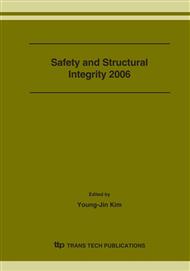p.2
p.3
p.9
p.15
p.21
p.25
p.31
p.37
p.43
Corrosion and Corrosion Fatigue Characteristics of CF8A Steel Degraded for 3 Months at 400°C
Abstract:
In this paper, as a fundamental study to evaluate fracture characteristics and material degradation by corrosion, evaluated electrochemical corrosion and corrosion fatigue characteristics of CF8A steel using as a material of the piping system in nuclear power plant. CF8A steel was artificially degraded at 400°C for 3 months. The environmental test condition is 3.5wt.% NaCl solution of room temperature. Corrosion rate of degraded CF8A steel in NaCl solution of room temperature increases with concentration of NaCl solution increase. However, concentration of NaCl solution will be more than 4.0wt.%, it shows decreasing tendency. Crack growth rates of degraded and not-degraded CF8A steel in air condition do not show remarkable difference. However, in 3.5wt.% NaCl solution, crack growth rates of them showed higher than ones in air. Particularly, crack growth rate of degraded material remarkably increases compare to one of notdegraded material.
Info:
Periodical:
Pages:
3-8
Citation:
Online since:
February 2007
Authors:
Price:
Сopyright:
© 2007 Trans Tech Publications Ltd. All Rights Reserved
Share:
Citation:


